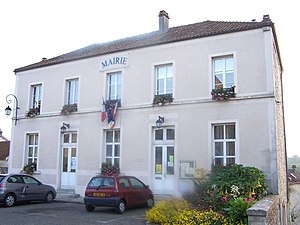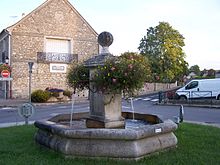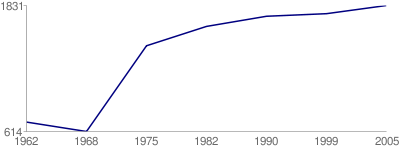Chavenay
| Chavenay | ||
|---|---|---|

|
|
|
| region | Île-de-France | |
| Department | Yvelines | |
| Arrondissement | Saint-Germain-en-Laye | |
| Canton | Saint-Cyr-l'École | |
| Community association | Gally Mauldre | |
| Coordinates | 48 ° 51 ′ N , 1 ° 59 ′ E | |
| height | 71-129 m | |
| surface | 6.03 km 2 | |
| Residents | 1,815 (January 1, 2017) | |
| Population density | 301 inhabitants / km 2 | |
| Post Code | 78450 | |
| INSEE code | 78152 | |
 Chavenay Town Hall |
||
Chavenay is a French commune in the department of Yvelines in the region Ile-de-France . It is located near Saint-Germain-en-Laye in the valley of the Ru de Gally and has 1815 inhabitants (as of January 1, 2017).
geography
Chavenay is 25 kilometers northwest of Paris in the valley of the Ru de Gally , which flows through the village in an east-west direction.
The closest municipalities are Saint-Nom-la-Bretèche in the northeast, Villepreux in the southeast, Les Clayes-sous-Bois in the south, Plaisir in the southwest, Thiverval-Grignon in the west, Davron in the northwest and Feucherolles in the north .
history
The name Chavenay can be traced back to Gallic or Roman times. The first written mention of the place can be found on a document from the year 1003, in which it is called in Latinized form as "Cavenoilus". However, the region around Chavenay was settled much earlier and contains evidence of Paleolithic settlement.
Prehistory and early history
Originally the area around Chavenay was inhabited by the Gallic tribes of the Carnutes and Parisians . With Diodorum, today's Jouars-Pontchartrain , there was a town nearby that was important during the first four centuries AD. In Chavenay itself, the remains of a Gallo-Roman villa were found, which was located near today's airfield.
middle Ages
From the 6th century AD, starting from the surrounding monasteries , Christianization began in the region. The area around Chavenay then belonged to the Saint-Germain-des-Prés Abbey , which had large estates until the Norman raids forced the monastery to be abandoned and the abbots placed themselves under the protection of the Dukes of Francis . Later gave Adelaide, wife of Hugh Capet the Priory of Argenteuil thirty Mansi country and the Church of Chavenay. This donation was confirmed by a certificate from Roberts the Pious in 1003 .
Until the middle of the 13th century, Chavenay remained threatened by raids by the Normans, which only became apparent under the reign of Louis XI. changed. During this time, the Chavenay economy developed positively and the population increased significantly. Thereupon the provost of Argenteuil decided to divert the Ru de Gally in order to irrigate the fields of the village and ensure the supply of the residents.
This economic boom was not ended until the Hundred Years War (1338–1453). Although Chavenay was spared direct armed conflicts between the French and English, changing ownership, the passing soldiers and plague epidemics hit the village hard.
Modern times
After the end of the Hundred Years War, the Argenteuil Priory pushed for the reconstruction of Chavenays and the repopulation by settlers from Argenteuil, to whom arable land was made available. In the course of the Huguenot Wars between Catholics and Reformed in the 16th century, however, there were again serious economic crises, as in the years of the Fronde between 1648 and 1653, and Chavenay lost most of its inhabitants. As the Argenteuil priory found it increasingly difficult to administer the relatively distant Chavenay, it was sold to Louis Phélypeaux de Pontchartrain in 1691 , ending the almost seven centuries of rule of the Agenteuil priory.
Under Phélypeaux, Chavenay benefited from the upgrading of the region by Louis XIV. The new landlord had the village church restored and alms given to the population. When the royal court moved to nearby Versailles , Chavenay also experienced an economic rise, as new job opportunities arose in agriculture, construction and at the court. Hunting, the favorite occupation of large parts of the court, led to frequent complaints among the farmers in the village.
The proximity to Versailles was Chavenay's undoing during the French Revolution and the reign of terror that followed. The church was largely destroyed, the cattle were stolen and many residents fled the village.
With the 19th century Chavenay experienced a fundamental social change. The farmers became owners of the previously leased land, which made the village society more autonomous and took over the administration of the place itself. The construction of a paper mill in 1825 marked the beginning of industrialization, and a sugar refinery created additional jobs in 1872. In 1860 the village school, which today serves as the town hall, was built, followed by a girls' school in 1888. In 1899 Chavenay was connected to the Versailles - Maule railway line .
After the world wars, the village initially struggled with the economic downturn. At the end of the 1960s, the Ru de Gally was built, which had previously repeatedly flooded the fields and parts of the village. With the construction of the new housing estate in 1972, the number of residents rose from 600 to 1,600.
politics
administration
Denis Flamant has been mayor of Chavenay since 2001. There is also a municipal council with eleven members. Chavenay belongs to the canton of Saint-Nom-la-Bretèche .
coat of arms
The coat of arms of Chavenay is divided vertically by a silver wavy band. The right side of the coat of arms shows a silver Madonna and Child on a blue background. On the left is a Phrygian helmet in gold in front of three ears of wheat, also gold, on a red background.
Town twinning
Since 1998, Chavenay and the neighboring communities of Crespières , Feucherolles and Saint-Nom-la-Bretèche have been twinned with the German town of Rösrath in North Rhine-Westphalia . On this occasion, a square in Chavenay was renamed Place de Rösrath .
Population development
The population of Chavenay is currently (as of 2007) 1,840 inhabitants, which is a slight increase compared to the values in 2005 (1,831 inhabitants) and 1999 (1,755). The working population in Chavenay consists of around 750 people, the majority of whom are engineers and managers. The proportion of under-20s among the residents is a relatively high 32%, 17% of the residents are 60 years or older.
| year | 1962 | 1968 | 1975 | 1982 | 1990 | 1999 | 2005 |
|---|---|---|---|---|---|---|---|
| Residents | 705 | 614 | 1,442 | 1,629 | 1,727 | 1,752 | 1,831 |
economy
Around 100 companies operate in Chavenay. In addition to local handicrafts and agricultural businesses, there are also larger companies in the fields of automobile production, precision mechanics and chemistry.
Attractions
See also: List of Monuments historiques in Chavenay
Chavenay has several farmhouses from the 17th to 18th centuries that are exemplary of the regional architecture. The two village schools, which date from the 19th century and one of which serves as the town hall today, have also been preserved.
The Saint Pierre church can be traced back to 1003. It was continuously expanded and rebuilt in the following eight centuries, so that today it combines a variety of historical architectural styles.
literature
- Le Patrimoine des Communes des Yvelines. Flohic Editions, Volume 2, Paris 2000, ISBN 2-84234-070-1 , pp. 886-890.
Web links
- www.chavenay.com - Official website of the municipality
- Statistics on the population of Chavenay. www.annuaire-mairie.fr
- Chavenay: Association pour la Protection du Patrimoine Culturel de Chavenay. www.patrimoine-chavenay.com
Individual evidence
- ↑ a b c d e f g h i j k Chavenay: Association pour la Protection du Patrimoine Culturel de Chavenay. www.patrimoine-chavenay.com. Retrieved March 12, 2010.
- ^ L'Equipe municipale. ( Memento of the original from March 10, 2010 in the Internet Archive ) Info: The archive link was inserted automatically and has not yet been checked. Please check the original and archive link according to the instructions and then remove this notice. www.chavenay.com. Retrieved March 12, 2010.
- ↑ a b Découvrir Chavenay. ( Memento of the original from March 10, 2010 in the Internet Archive ) Info: The archive link was inserted automatically and has not yet been checked. Please check the original and archive link according to the instructions and then remove this notice. www.chavenay.com. Retrieved March 16, 2010.
- ↑ Statistics on the population of Chavenay. www.annuaire-mairie.fr. Retrieved March 17, 2010.





